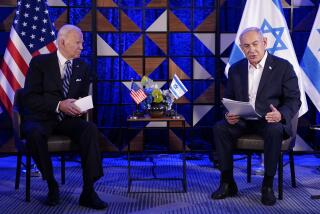Post-Cold War Period Full of Hopes for Peace, Prosperity
President Bush will meet Soviet President Mikhail S. Gorbachev on Tuesday in Madrid, and Wednesday he will kick off historic peace talks that may result in significant breakthroughs for Israel and its Arab neighbors.
But then he’ll come home to an economy as cold and clammy as a Halloween ghost. Each new statistic on consumer worries or declining factory orders adds to fears of grim times ahead.
It’s a confusing picture of triumph abroad and terror at home, one that’s leading many Americans to doubt U.S. power and influence and to question whether their government is trying to do too much for other people.
The doubts are misplaced. U.S. power is no illusion, and its economic troubles are no mystery. What’s really going on is that the U.S. economy is in a post-Cold War downturn that has much in common with other postwar periods. In the aftermath of World Wars I and II, the economy went into a swoon when military production ceased. Today, the economy is stagnating as the defense spending of the 1980s winds down.
There are other parallels. Just as the United States emerged more powerful from each of the earlier wars, today it is the single superpower, politically and militarily, after its long competition with Soviet communism.
That’s important to keep in mind because there are lessons--particularly for President Bush--in how the United States used its power in the past.
After World War I, it dropped the ball, allowing the U.S. economy to slide into a serious recession in 1921 and remaining a bystander as other nations suffered economic and political upheavals and became violent dictatorships. The consequences of that unstable world included the Great Depression and ultimately another war.
The aftermath of World War II was dramatically different. At home, the government made full employment a national policy and used tax measures to boost home construction and stem a postwar downturn. Abroad, it offered the Marshall Plan to Europe and aid to Japan, spurring their economies to historic levels of prosperity.
Helping others fostered unprecedented growth at home: The U.S. economy grew threefold from 1919 to 1946 but has grown more than 20 times since the end of World War II.
And that brings us to what will happen this time:
* The Middle East peace talks will be surprisingly successful, mainly because of U.S. government policies and priorities.
* The meeting with Gorbachev is important too. There will be some aid for the Soviet Union to prevent a slide into chaos and to keep open a growth market for U.S. goods and services.
* The U.S. economy will get new injections. Interest rates will be cut again in the next two to three weeks. Tax cuts will follow next year.
Don’t buy predictions that the Middle East talks will produce little. Yes, Israel and its Arab neighbors distrust each other. But all are dependent on the United States and all need investment from global markets. So they will compromise.
Watch for progress to begin with Syria and Israel, says Col. Oded Neumann, a retired Israeli intelligence officer now lecturing in the United States. Syrian President Hafez Assad, having seen his backer the Soviet Union collapse, wants to attain the kind of aid and marketacceptance that Egypt received after the Camp David accords in 1978, Neumann says. Egypt receives $2.5 billion a year in U.S. aid and has been able to borrow globally because it is an ally of the West. Syria has no such access and wants it badly.
Israel will deal because it needs U.S. help to borrow on world markets to settle an influx of Soviet immigrants. Talks with Palestinians over rights in the West Bank and Gaza territories will be difficult, but the Palestinians may compromise because they also need U.S. economic support, says Middle East scholar William Quandt of Brookings Institution.
Most of all, watch for Israel and the Arab countries, at the United States’ behest, to set about reforming their state-dominated economies, just as Eastern Europe and the Soviet Union are doing.
Economic reform, not handouts, is what all the talk of Marshall Plans for Eastern Europe and the Middle East is about. It’s a direct reflection of the post-World War II success, says Prof. Barry Eichengreen of UC Berkeley. The original Marshall Plan didn’t so much involve money, explains Eichengreen, as it did guidance on running a modern capitalist economy.
As for its own economy, the U.S. government will pull out the stops, pushing interest rates lower and achieving some kind of tax reduction. And the economy will respond to stimulus, as usual.
That still leaves the transition from defense. After World War II, wartime aircraft manufacturing was transformed into the aerospace-defense industry. The challenge now is to guide that industry’s transformation to peacetime.
The task does not seem insurmountable, nor something to be feared like hobgoblins. But the economy’s transition won’t be automatic . Rather, transformation of the defense business will demand organized effort and political will--much more effort and will than the President and Congress have shown so far.
Almost 50 years ago after World War II, political wisdom and courage launched a long postwar prosperity. No reason the new postwar period can’t see the same--if wisdom and courage are there.
A History Lesson
The economic downturn of this post-Cold War period, starting with the fall of the Berlin Wall in November 1989, may be likened to the downturns that followed World Wars I and II as wartime production eased off.
More to Read
Get the L.A. Times Politics newsletter
Deeply reported insights into legislation, politics and policy from Sacramento, Washington and beyond. In your inbox three times per week.
You may occasionally receive promotional content from the Los Angeles Times.










